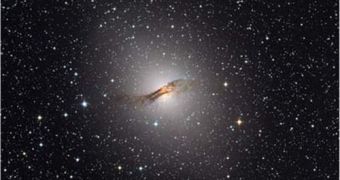In orbit only since June 2008, the Fermi Gamma-ray Space Telescope has already produced some remarkable science. One of the most remarkable findings it made so far was the fact that the closest active galaxy to the Milky Way, called Centaurus A, is capable of emitting both gamma-rays and radio radiation. In previous studies, it was proposed that a galaxy could either emit one or the other, but the new data seems to indicate that both types of emissions are possible at the same time.
An active galaxy is a space structure whose central region emits radiation across a very wide portion of the electromagnetic spectrum. Generally, the core is occupied by a supermassive black hole, which gobbles up matter, and then releases vast amounts of radiation in exchange. In the case of Centaurus A, which has for a long time been determined to be one of the most potent and bright sources of radio wavelengths in the sky, the core produced vast amounts of extremely high-energy gamma-rays as well, Space reports.
“This is something we've never seen before in gamma-rays,” explains of the new Fermi findings expert Teddy Cheung. He is a member of the team managing the observatory, and is based in Washington DC, at the Naval Research Laboratory (NRL). As far as physicists go, gamma-rays represent the most energetic form of light possible in the Universe. But, inside Centaurus A, these photons are ramped up to even higher energies than usual. The huge lobes of the active galaxy contain super-strong magnetic fields, in which a wide variety of particles get accelerated. The gamma-rays entering these highly-active regions also get a massive energy boost.
This results in what can perhaps be best described as the most energetic photons in the known Universe. Astrophysicists suspect that the situation is not unique and say that many of the active, massive galaxies out there may be producing the same amplification effect on their own gamma-ray sources. “Not only do we see the extended radio lobes, but their gamma-ray output is more than 10 times greater than their radio output,” Cheung adds. More details of the study appear in the April 2 issue of the esteemed publication Science.

 14 DAY TRIAL //
14 DAY TRIAL //